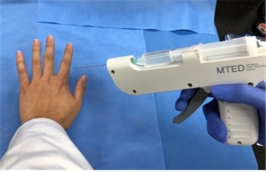제목
Good News for Medical, Sanitary and Cosmetics Businesses
Office of Information | 2018-11-23 | 조회 4556
본문 내용

Nanomembranes are nanosized membranes with lots of potential, as we can mix various materials with the polymer solution to give the desired functions and spray them directly on the desired targets. Thus, they have been used for many different purposes in industries including water treatment, energy, health and agriculture.
A CBNU doctoral student, Do-hee Lee (Bionano Systems Engineering) has developed a portable electric radiation device capable of producing polymer nanomembranes with high voltage over 15kv. In particular, Lee has established a laboratory startup company "Nanofire Lab" to commercialize the device.
The new device was inspired by the static electricity generated in everyday life. It artificially rubs two materials of different charge heat by motor rotation force and enables high voltage electric generation due to polarity change through charge transfer between the materials.
Compared to the conventional composition of heavy and large electric radiation devices, such as high voltage supply devices, metal nozzles, syringe pumps, collecting boards and chambers, the new 20 centimeter-long device is much lighter, making it easier to control even with just one hand.
With this small but innovative device, the same level of nanomembranes as the existing ones can be manufactured. Thus, it is expected to expand the previous lab-only use to practical use in daily life.
“By modifying the blend of functional polymer cartridges installed in the portable electric radiation device, the cartridges mixed with biocompatible polymers and drugs can be applied to the bio-fields, such as hemostasis (to stop bleeding), wound care and burn treatment,” said Lee. “Once commercialized, there could be a wide range of applications to fields ranging from air filtering (pm2.5 micro dust blocking, VOC abatement, antibacterial filters, etc.) to cosmetics, using natural polymer cartridges.”
The technology has been researched and developed with the support of the Korean Ministry of Science and ICT. The prototype and the start-up were carried out with the support of the Chonbuk National University Startup Support Center.





















